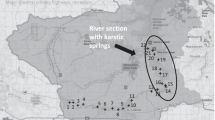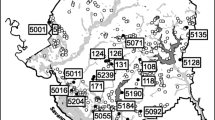Abstract
Best management practices (BMPs) have been developed to address soil loss and the resulting sedimentation of streams, but information is lacking regarding their benefits to stream biota. We compared instream physical habitat and invertebrate and fish assemblages from farms with BMP to those from farms with conventional agricultural practices within the Whitewater River watershed of southeastern Minnesota, USA, in 1996 and 1997. Invertebrate assemblages were assessed using the US EPA's rapid bioassessment protocol (RBP), and fish assemblages were assessed with two indices of biotic integrity (IBIs). Sites were classified by upland land use (BMP or conventional practices) and riparian management (grass, grazed, or wooded buffer). Physical habitat characteristics differed across buffer types, but not upland land use, using an analysis of covariance, with buffer width and stream as covariates. Percent fines and embeddedness were negatively correlated with buffer width. Stream sites along grass buffers generally had significantly lower percent fines, embeddedness, and exposed streambank soil, but higher percent cover and overhanging vegetation when compared with sites that had grazed or wooded buffers. RBP and IBI scores were not significantly different across upland land use or riparian buffer type but did show several correlations with instream physical habitat variables. RBP and IBI scores were both negatively correlated with percent fines and embeddedness and positively correlated with width-to-depth ratio. The lack of difference in RBP or IBI scores across buffer types suggests that biotic indicators may not respond to local changes, that other factors not measured may be important, or that greater improvements in watershed condition are necessary for changes in biota to be apparent. Grass buffers may be a viable alternative for riparian management, especially if sedimentation and streambank stability are primary concerns.
Similar content being viewed by others
Author information
Authors and Affiliations
Rights and permissions
About this article
Cite this article
NERBONNE, B., VONDRACEK, B. Effects of Local Land Use on Physical Habitat, Benthic Macroinvertebrates, and Fish in the Whitewater River, Minnesota, USA. Environmental Management 28, 87–99 (2001). https://doi.org/10.1007/s002670010209
Issue Date:
DOI: https://doi.org/10.1007/s002670010209




